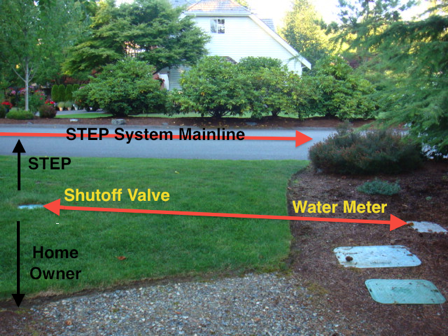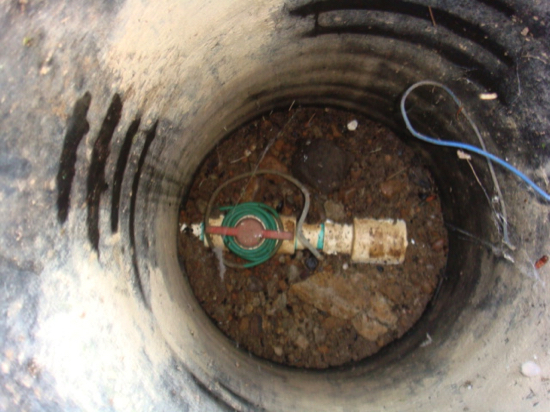Here we discuss one of the most important components in your STEP system, the shut-off valve. The shut-off valve allows you to isolate your system from the STEP system mainline. This is important should there be a need to perform maintenance on the mainline or there is a critical failure at your homes connection to the mainline. Whatever the reason, if the need arises we must be able to immediately isolate you from the mainline. Therefore, locating and providing easy access to this shutoff valve is critical for you, the homeowner, and for the STEP Association maintenance team.

The picture above shows a standard installation of a shut-off valve on many Canterwood Properties. Unfortunately, the builder and system installers in Division 12 did not follow consistent installation guidelines which would allow us to easily locate these shut-off valves in all properties. In the picture above the valve box is located within 10-15 feet of the water meter box. Other homes have a shutoff valve box located nearer the outlet of the liquids vault. In Division 12 there does seem to be consistency in the type of valve boxes that the builder used. In searching for yours look for a green irrigation type rectangular box which may or may not have “SEWER” on the cover. If you cannot easily find your shutoff valve box, it is likely buried under vegetation or mulch or it is visible and you thought it was an irrigation system valve box.
Hints for beginning your search: First find any irrigation type boxes in your yard between your tanks and the street and pull off the covers. Irrigation, i.e., sprinkler valves are close to the surface, relatively small and have wires coming out of each them. You may also find your back-flow preventers, generally 2 inline bronze valves associated with your sprinkler and potable water supply, also in an irrigation box. Your STEP shut-off valve is a single valve (see next picture as example of one type of shut-off ball valve used) or you may have what appears to be an empty box. Rodent activity can cause the valve to become buried so all you see is dirt. Dig carefully in the box and expose all aspects of the valve. There also should be a wire in the box (non-energized). This wire is in place as a tracer wire to help locate the line and the valve. More about that wire below.
If you are still unable to find this shut-off box, you can consult your “As Built” plans if you have them. These are not always accurate but may help you figure out where to search. If that fails you will have to call a Utility Finding service. All pipes to the main line were supposed to be installed with a tracer wire — a wire that can be detected by an underground utility finding service. Some of the Service Providers listed on this page can be called to perform the trace from your riser tank lids and find your shutoff box.
Once you find and expose the shut-off valve box, open it and you will see something similar to the picture directly below. Generally, it is ball valve of some type. A red handled valve is shown here in the box/enclosure, but it could also have a handle more like a lever. Regardless, the handle position notes whether the valve is open or closed. When the handle is running parallel with the pipe, as this one is, it is open and your home is connected to the mainline. When it is perpendicular to the pipe it is closed and your home has been shut-off from the mainline.

_________________________________________________________________________________________________________________________________________________________
Important Notes about your Shut-off value:
#1: If you ever need to close this valve you must turn the power off to your STEP system pump. Failure to do so can cause your pump to run non-stop, potentially damaging your pump. Once you have turned off power to the pump you can still use your water but we recommend limiting the use of water. Be very selective. If your STEP vaults fill there is only one place for the waste to go, out the seals in your toilets and bath tubs.
#2: Your shutoff valve box lid and all of your access lids, must be visible and not covered with vegetation or mulch/dirt. Please make sure you know the location of all and keep them visible.
#3: After you find your shut-off box, you should record and file its location in your personal home files. Landscapers can bury boxes easily and it could become “lost” again. It is helpful to measure and record the distance from 2 separate fixed/semi-permanent or permanent locations to the center of the valve box. The intersecting arcs (triangulation) formed by these two measurements will locate your box. This practice will significantly aid future efforts to find “lost” boxes and saves time and money in the future.
Important Notes about your Shut-off value:
#1: If you ever need to close this valve you must turn the power off to your STEP system pump. Failure to do so can cause your pump to run non-stop, potentially damaging your pump. Once you have turned off power to the pump you can still use your water but we recommend limiting the use of water. Be very selective. If your STEP vaults fill there is only one place for the waste to go, out the seals in your toilets and bath tubs.
#2: Your shutoff valve box lid and all of your access lids, must be visible and not covered with vegetation or mulch/dirt. Please make sure you know the location of all and keep them visible.
#3: After you find your shut-off box, you should record and file its location in your personal home files. Landscapers can bury boxes easily and it could become “lost” again. It is helpful to measure and record the distance from 2 separate fixed/semi-permanent or permanent locations to the center of the valve box. The intersecting arcs (triangulation) formed by these two measurements will locate your box. This practice will significantly aid future efforts to find “lost” boxes and saves time and money in the future.